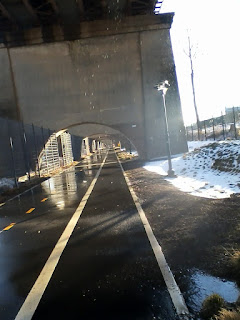Yesterday I wrote about the penultimate multiday tour I've taken. It was the ride that, more than any other, changed my life.
Near the end of that tour, I climbed le Col du Galibier (a couple of days after pedaling up l'Alpe d'Huez) and descended into the valley, where I checked into a small hotel in St. Jean de Maurienne. The town is next to the Italian border and, though you may not have heard of it, you surely have seen the thing for which the town is best known: Opinel knives. (Yes, they are still made there and in nearby Chambery, a small city that just oozes with Savoyard charm.) After checking into the hotel, I walked into the town square in search of something to eat. That is when I saw a woman, who was not distinctive in any way, crossing a street. She was probably on her way home from work. For whatever reasons, I saw in the way she occupied space and time, the way I was meant to live.
After writing the post, I couldn't stop thinking about that day, and more to the point, what has changed since then, for me and the world.
For one thing, when I returned, my then-partner surprised me by meeting me at JFK Airport. As tears trickled down my cheeks, she embraced me. I held her--actually, I held on: To this day, I see that hug as the single most desperate act of my life. I knew that my life would not continue, at least not for very long, as it had.
Even if I hadn't seen that woman in St. Jean de Maurienne, I would have, eventually, undergone the process of affirming my gender identity. But, I believe, some things--including the September 11 attacks a few weeks later--accelerated the timeline. I was home that but my partner was in her office near Rockefeller Center. Subway and bus service was suspended, so she and thousands of other people had to leave Manhattan on foot. I met her on the Brooklyn side of the Manhattan Bridge. All I could think about was how easily she--and any one of the people crossing that bridge--and I--could have been incinerated or crushed in those towers.
Undergoing my affirmation process, which began, gradually, with visits to counselors and therapists a few months later, changed my cycling. Aging would have done it, but taking hormones probably sped up the process. I still like to ride aggressively and show off, sometimes, but I now realize that I now ride more for my mental health than to show off any kind of physical prowess.
Oh, and I no longer have the bike or clothes I rode during my 2001 tour. The Voodoo Wazoo, built for cyclocross, was actually a good bike for the ride I took. But eventually I found myself wanting to change everything in my life, and I sold it--ironically, to pay the air fare for my next trip to France. And those clothes--do they scream '' 90s mountain biker," or what? I was indeed still doing some offroad riding, and still owned a proper mountain bike (a Bontrager Race Lite with Rock Shox Judy forks) but I eventually sold that bike and stuck mainly to road riding because I was starting to notice that I didn't heal as quickly from wounds and injuries as I did when I was younger and--OK, this will show how much gender stereotypes still shaped my thinking--I felt that I could be more dignified, ladylike if you will, on a road or city bike.
Now, I don't expect to return to mountain biking because, really, I prefer to stick to a couple of kind of riding. Also, mountain bikes seem to "age" more quickly than other kinds of bikes. On the other hand, I can ride one of my Mercians just as easily today as I did (or could have, in the case of my newer ones) five or ten years ago, and barring crashes or inability on my part, I should be able to ride them--while replacing only the parts that normally wear out, like chains and tires-- for years to come.
In other words, I expect my tour to continue--precisely because it changed the day I rode up the Col du Galibier.
.jpg)
.jpg)





















.jpg)





